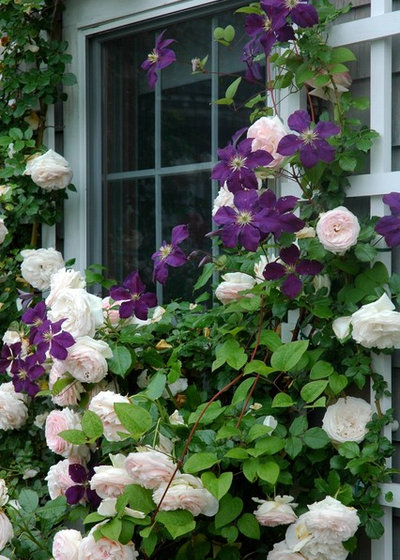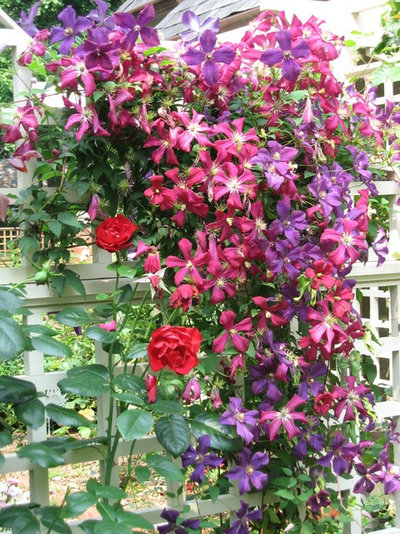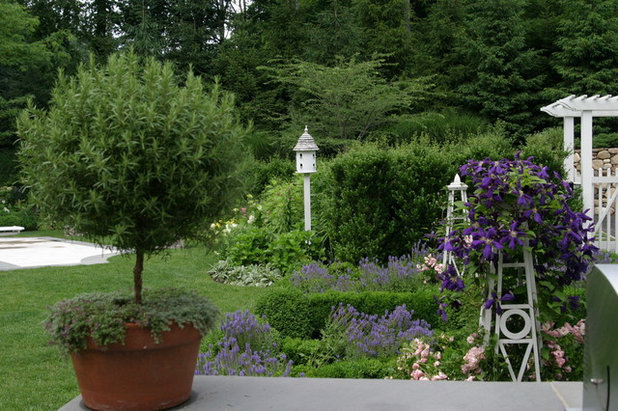I love lush, abundant gardens, but in small spaces they can be difficult to achieve, due to narrow borders that don’t allow for multiple layers of trees and shrubs. The answer when you can’t go out is to go up, using one climbing plant to support another; the classic example of this is the pairing of a rose and a clematis.
I usually allow a newly planted climbing rose two full growing seasons to become established and gain some height before adding a clematis, although it is possible to plant both at the same time. The rose will need to be tied onto its support, but the clematis has a natural twining habit and will attach itself to the rose stems and leaves by means of its tendrils.

Le jardinet
How to select your plants. The first consideration is whether you want the rose and the clematis to bloom together or sequentially. Are you looking to extend the flowering season, or are you looking for a major blast of color in a particular month?
Then think about color. If the two plants will bloom at the same time, you can select flowers that contrast or harmonize to suit the color scheme of your garden, your home and your personal taste. I highly recommend the book
The Rose and the Clematis, by John Howells, to explore combinations, suggestions for specific cultivars and design ideas.

Le jardinet
How to Use the Combination1. To soften a home’s facade. Many homes feature a prominent two- or three-car garage that can be visually overwhelming. Sometimes a pocket of soil will be left at the base of each supporting column, which at first glance has little potential. Yet this is the perfect size to plant both a rose and a clematis to add color and drama to the facade.
Here the intensely fragrant Westerland rose perfumes the air and acts as a support for the purple clematis (
Clematis jackmanii ‘Superba’). These two are planted on either side of a wide garage, scrambling up a discreet trellis until they reach a decorative pergola that spans the top. Three years after their planting, both roses and clematises are mingling in a glorious colorful profusion, draping the pergola in midsummer — a truly unforgettable sight.

MJ McCabe-Garden Design
2. To frame a window. Shorter roses and clematises are ideal for framing windows, as shown here, although some occasional, judicious trimming may be necessary.
An advantage of growing these two plants together is that with correct pruning, the clematis will flower from the base to the top, its flowers masking the inevitable “bare legs” of the climbing rose.

Susan Cohan, APLD
3. For seasonal screening. This designer has taken the concept one step further by combining two clematises and a tall rose on a decorative trellis. The increased density of foliage and flowers helps with privacy screening during the summer.

Rock Spring Design Group LLC (David Verespy, ASLA)
Planting tips. Both plants thrive in rich, moisture-retentive but well-drained soil in full sun. Clematis prefers shade at its roots, which can be provided by a ground cover.
Dig a planting hole to a depth of 2 feet and work in some compost. The hole should be wide enough to accommodate the roots easily.
Plant the rose no deeper than it was in the container. There are conflicting reports as to the benefit of planting a clematis deeper than it was in the pot; some suggest that planting deeper reduces the chance of fungal disease (wilt), while others refute that. Personally I
do plant it 2 to 4 inches deeper and seem to get stronger growth as a result.
Fertilizer. Both roses and clematises benefit from a handful of bonemeal being added to the hole at planting time to promote strong root development. A 2- to 3-inch layer of compost over the root zone in winter is also beneficial, but keep this away from the clematis stems.
Alfalfa promotes the growth of new canes and stems from the base of both the rose and the clematis. Gently work a cupful into the soil surface in spring and again after the plants flower. Alternatively, use an organic rose fertilizer as directed; this will be suitable for both plants.

Le jardinet
Pruning and DeadheadingRoses: Seek the advice of a rosarian for pruning recommendations for your rose variety. Generally, climbing roses do not need pruning except for shape or rejuvenation. If the rose blooms only once and then sets rose hips, do not cut off the dead flowers. If it is a repeat bloomer, you will need to remove old flowers to encourage a fresh flush of blooms later in the season.
Clematis: It is important to know what type of clematis you have, as the timing and degree of pruning are crucial. Seek the advice of a local nursery professional or specialist. It is not necessary to deadhead clematis.
More: Climbing Plants Suit Small Gardens





